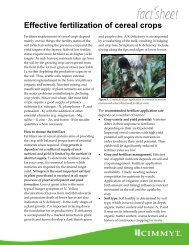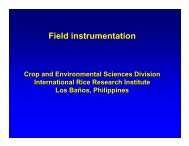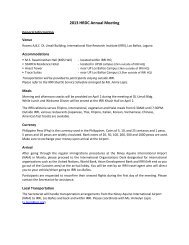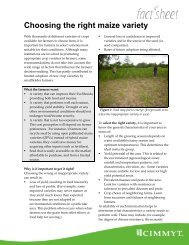soil micronutrient deficiencies in the rice-wheat cropping system.pdf
soil micronutrient deficiencies in the rice-wheat cropping system.pdf
soil micronutrient deficiencies in the rice-wheat cropping system.pdf
Create successful ePaper yourself
Turn your PDF publications into a flip-book with our unique Google optimized e-Paper software.
Soil Micronutrient Deficiencies <strong>in</strong><br />
<strong>the</strong> Rice-Wheat Cropp<strong>in</strong>g System<br />
Zn deficient Unaffected ZnSO 4<br />
treated<br />
M<br />
icronutrient <strong>deficiencies</strong> <strong>in</strong> <strong>the</strong> Indo-Gangetic Pla<strong>in</strong>s (IGP) started emerg<strong>in</strong>g with<br />
<strong>the</strong> adoption and spread of <strong>in</strong>tensive agriculture <strong>in</strong> <strong>the</strong> region. Imbalanced use of<br />
macronutrient fertilizers, decreased use of organic manure, reduced recycl<strong>in</strong>g of crop<br />
residues, and bumper harvests <strong>in</strong> <strong>the</strong> past three decades have <strong>in</strong>duced secondary and<br />
<strong>micronutrient</strong> <strong>deficiencies</strong> <strong>in</strong> <strong>the</strong> IGP. In several areas with <strong>in</strong>tensive cropp<strong>in</strong>g, z<strong>in</strong>c (Zn)<br />
deficiency appeared <strong>in</strong>itially and subsequently <strong>the</strong> <strong>deficiencies</strong> of iron (Fe), manganese (Mn),<br />
boron (B), and molybdenum (Mo) were recorded. The severity of <strong>the</strong>se <strong>deficiencies</strong><br />
depended on <strong>the</strong> <strong>soil</strong> conditions and <strong>the</strong> crop grown. Rice crop removes larger quantities<br />
of <strong>micronutrient</strong>s compared to <strong>wheat</strong>. Increase <strong>in</strong> fertility levels progressively <strong>in</strong>creases <strong>the</strong><br />
total removal of <strong>micronutrient</strong>s due to <strong>in</strong>creased dry matter production.<br />
Uptake (kg/ha) of Micronutrients by Rice and Wheat<br />
Fertility Biomass (t/ha) Rice Wheat<br />
level* Rice Wheat Zn Cu Mn Fe Zn Cu Mn Fe<br />
Control 6.5 4.1 0.12 0.09 0.35 1.68 0.07 0.03 0.11 0.70<br />
Low 8.8 7.5 0.17 0.13 0.57 2.51 0.12 0.05 0.21 1.30<br />
Medium 12.9 10.2 0.25 0.19 0.80 3.43 0.17 0.08 0.28 1.83<br />
High 14.5 12.4 0.30 0.22 0.97 4.06 0.20 0.09 0.33 2.33<br />
* Control = 0:0:0;<br />
Low = 60:30:30<br />
Medium= 120:60:60<br />
High = 180:90:90 of N:P 2<br />
O 5<br />
:K 2<br />
O<br />
Source: Gupta and Mehla, 1993
Rice and <strong>wheat</strong> are important <strong>in</strong> <strong>the</strong> national food security of <strong>the</strong> IGP. The <strong>rice</strong>-<strong>wheat</strong><br />
<strong>system</strong>, though remunerative, has resulted <strong>in</strong> <strong>the</strong> over-exploitation of <strong>the</strong> natural <strong>soil</strong><br />
resource base, which has been fur<strong>the</strong>r enhanced by <strong>the</strong> imbalanced use of <strong>in</strong>puts. Cont<strong>in</strong>ued<br />
emphasis on maximization of food gra<strong>in</strong> production without appropriate management<br />
practies from a shr<strong>in</strong>k<strong>in</strong>g land resource base will result <strong>in</strong> fur<strong>the</strong>r depletion of <strong>micronutrient</strong><br />
reserves. The simplest solution to alleviate <strong>micronutrient</strong> deficiency is <strong>the</strong> application of<br />
<strong>micronutrient</strong> fertilizers to <strong>the</strong> crop.<br />
Problems <strong>in</strong> Alleviat<strong>in</strong>g Micronutrient<br />
Deficiencies<br />
• Difficulty <strong>in</strong> <strong>the</strong> identification of field crop deficiency<br />
symptoms.<br />
• Variation <strong>in</strong> <strong>soil</strong> <strong>micronutrient</strong> status, <strong>soil</strong> pH, ra<strong>in</strong>fall duration<br />
and <strong>in</strong>tensity, and seasonal fluctuations <strong>in</strong> <strong>the</strong> groundwater<br />
levels and temperature regimes <strong>in</strong> <strong>the</strong> region.<br />
• Inadequate facilities and field tests to validate critical levels of<br />
<strong>soil</strong> and plant <strong>micronutrient</strong>s <strong>in</strong> <strong>the</strong> region.<br />
Source of Micronutrients<br />
<strong>in</strong> Soils<br />
• Soil parent material<br />
• Industrial and urban<br />
effluents<br />
• Agricultural chemicals<br />
and fertilizers<br />
• Irrigation water<br />
If <strong>micronutrient</strong> <strong>deficiencies</strong> that<br />
constra<strong>in</strong> high productivity are not<br />
identified, monitored, and alleviated,<br />
<strong>the</strong> fertilizer use efficiency of costly<br />
chemical fertilizers and o<strong>the</strong>r<br />
agricultural <strong>in</strong>puts will be markedly<br />
reduced. The projected <strong>micronutrient</strong><br />
demand for 2025 <strong>in</strong> India is expected<br />
to <strong>in</strong>crease by five to 10 times <strong>the</strong><br />
present consumption level (Sehgal,<br />
1999). This would entail <strong>the</strong> use of<br />
fertilizer nutrients <strong>in</strong> <strong>the</strong> right<br />
proportion, with efficient application<br />
methods and at <strong>the</strong> appropriate time<br />
of crop growth. Also, it is essential to<br />
augment <strong>the</strong> availability of native<br />
nutrients by modify<strong>in</strong>g <strong>soil</strong><br />
environment through<br />
management practices <strong>in</strong> different<br />
crops and cropp<strong>in</strong>g <strong>system</strong>s.<br />
Projected Demand for Micronutrients <strong>in</strong> India<br />
Total and Available Micronutrient Content of Indian Soils<br />
Micronutrient Total content Available <strong>micronutrient</strong><br />
(mg/kg <strong>soil</strong>) (mg/kg <strong>soil</strong>)<br />
Content<br />
Mean<br />
Z<strong>in</strong>c 2 to 1,019 0.2 to 6.9 0.9<br />
Copper 1.9 to 960 0.1 to 8.2 2.1<br />
Iron 2700 to 191,000 0.8 to 196 19.0<br />
Manganese 37 to 11,500 0.2 to 118 21.0<br />
Boron 3.8 to 630 0.08 to 2.6 -<br />
Molybdenum 0.01 to 18.1 0.07 to 7.67 -<br />
Source: Takkar, 1982; S<strong>in</strong>gh, 1999
Extent of Micronutrient Deficiencies<br />
The total <strong>micronutrient</strong> contents of <strong>soil</strong>s are of limited value to plant growth and responses<br />
to <strong>the</strong>ir application. To match <strong>the</strong> levels of <strong>micronutrient</strong>s <strong>in</strong> <strong>soil</strong> with plant requirement,<br />
<strong>the</strong>ir available contents <strong>in</strong> <strong>soil</strong>s are determ<strong>in</strong>ed. Like total contents, <strong>the</strong> available<br />
<strong>micronutrient</strong> status of <strong>soil</strong>s is also highly variable. Soil properties exercise a considerable<br />
<strong>in</strong>fluence on <strong>the</strong> availability of <strong>micronutrient</strong>s. Therefore, <strong>the</strong> extent of <strong>micronutrient</strong><br />
deficiency varies not only <strong>in</strong> different states and districts but also <strong>in</strong> different blocks with<strong>in</strong><br />
<strong>the</strong> same district depend<strong>in</strong>g upon <strong>the</strong> <strong>soil</strong> characteristics and o<strong>the</strong>r management conditions.<br />
Extent of Micronutrient Deficiency <strong>in</strong> <strong>the</strong> Soils of India<br />
State No. of <strong>soil</strong> Percent <strong>soil</strong> samples deficient<br />
samples Zn Cu Fe M n<br />
Bihar 19214 54.0 3 6 2<br />
Haryana 21848 60.5 2 20 4<br />
Punjab 16483 48.1 1 14 2<br />
Uttar Pradesh 26126 45.7 1 6 2<br />
West Bengal 6547 36.0 0 0 3<br />
Total 90218 50.6 2 10 3<br />
Source: S<strong>in</strong>gh, 1999<br />
Areas of Deficiency<br />
• Z<strong>in</strong>c deficiency is <strong>the</strong> most widespread <strong>in</strong> <strong>the</strong> four IGP countries (Bangladesh, India,<br />
Nepal, Pakistan).<br />
• Some areas <strong>in</strong> Punjab, India revealed a marked decrease <strong>in</strong> <strong>the</strong> extent of z<strong>in</strong>c<br />
deficiency but <strong>the</strong>re has been an <strong>in</strong>crease <strong>in</strong> <strong>the</strong> deficiency of iron and manganese.<br />
• The extent of iron deficiency is approximately a fifth that of z<strong>in</strong>c deficiency and is<br />
largely <strong>in</strong>fluenced by <strong>the</strong> vast areas under alkal<strong>in</strong>e to calcareous <strong>soil</strong> tracts.<br />
• Iron deficiency is only second <strong>in</strong> importance after z<strong>in</strong>c deficiency <strong>in</strong> Punjab and<br />
Haryana <strong>in</strong> India.<br />
• Manganese deficiency is <strong>in</strong> localized sites where <strong>rice</strong>-<strong>wheat</strong> crop rotation is practiced <strong>in</strong><br />
coarse-textured <strong>soil</strong>s.<br />
• Copper deficiency is not widespread <strong>in</strong> <strong>the</strong> IGP, but deficiency based on plant analysis<br />
is higher than <strong>soil</strong> analysis. The critical limits used for <strong>soil</strong> copper or plant copper need<br />
to be re-calibrated.<br />
• The <strong>in</strong>cidence of boron deficiency was highest <strong>in</strong> <strong>the</strong> acid <strong>soil</strong>s of West Bengal<br />
followed by <strong>the</strong> calcareous <strong>soil</strong>s of Bihar.<br />
Diagnosis of Micronutrient Deficiency<br />
The assessment of <strong>micronutrient</strong> deficiency can be made through visual leaf symptoms and<br />
<strong>soil</strong> and plant analyses. Response of crops to <strong>the</strong> application of <strong>micronutrient</strong>s not only<br />
confirms <strong>the</strong> <strong>deficiencies</strong> but also helps <strong>in</strong> determ<strong>in</strong><strong>in</strong>g nutrient needs.
Deficiency Symptoms<br />
Visual recognition of leaf symptoms is important <strong>in</strong> <strong>the</strong><br />
identification of nutrient disorders <strong>in</strong> crops. Nutrients like iron and<br />
boron, which are not readily translocated from old to young leaves<br />
under stress conditions with<strong>in</strong> <strong>the</strong> plant are called immobile<br />
nutrients and <strong>the</strong>ir deficiency symptoms first appear on young leaves. Due to <strong>the</strong><br />
Visual symptoms of z<strong>in</strong>c<br />
deficiency <strong>in</strong> <strong>rice</strong><br />
plants first appear<br />
on older leaves.<br />
variable mobility of z<strong>in</strong>c, copper, molybdenum, and manganese under conditions of <strong>the</strong>ir<br />
deficiency, <strong>the</strong> location of <strong>the</strong>ir symptoms <strong>in</strong> different crops and crop species may vary<br />
depend<strong>in</strong>g upon <strong>the</strong> degree of <strong>the</strong>ir mobility. Confident diagnosis by this method, however,<br />
requires much experience, as <strong>the</strong> symptoms of some nutrient <strong>deficiencies</strong> are difficult to<br />
differentiate without a thorough knowledge. Ano<strong>the</strong>r limitation of this technique is that by<br />
<strong>the</strong> time <strong>the</strong> deficiency symptoms appear, <strong>the</strong> crop has undergone a marked set back and<br />
<strong>the</strong> corrective measures taken at that time may not produce optimum yields. The diagnosis<br />
by this method should be confirmed through <strong>soil</strong> and plant analyses followed by design<strong>in</strong>g<br />
experiments of crop response to <strong>the</strong> added <strong>micronutrient</strong> of <strong>in</strong>terest.<br />
Plant Analysis<br />
Plant analysis is widely used as a means of detect<strong>in</strong>g micronturient deficiency and <strong>the</strong> need<br />
for fertiliz<strong>in</strong>g <strong>the</strong> crops. Under conditions of hidden <strong>micronutrient</strong> deficiency, plant analysis<br />
is <strong>the</strong> most effective method for diagnosis of <strong>micronutrient</strong> disorders. This is because<br />
nei<strong>the</strong>r <strong>the</strong> plant exhibits visual deficiency symptoms, nor do <strong>the</strong> <strong>soil</strong> tests precisely predict<br />
such situations.<br />
Soil Analysis<br />
Soil analysis is an <strong>in</strong>valuable and convenient diagnostic tool for quick and timely assessment<br />
of micronturient availability. Several chemical extraction procedures have been used to<br />
measure <strong>the</strong> plant available <strong>micronutrient</strong>s.
Critical Levels for Micronutrients <strong>in</strong> <strong>the</strong> IGP<br />
Future Micronutrient Research Needs<br />
The relatively m<strong>in</strong>or problem of <strong>soil</strong> <strong>micronutrient</strong> deficiency at<br />
<strong>the</strong> beg<strong>in</strong><strong>in</strong>g of <strong>the</strong> Green Revolution three decades ago is a<br />
factor to reckon with <strong>in</strong> present times <strong>in</strong> susta<strong>in</strong><strong>in</strong>g <strong>the</strong><br />
productivity of <strong>rice</strong> and <strong>wheat</strong> <strong>in</strong> <strong>the</strong> IGP. The monoculture of<br />
<strong>rice</strong> and <strong>wheat</strong> of <strong>the</strong> past has given rise to an exhaust<strong>in</strong>g <strong>soil</strong><br />
<strong>micronutrient</strong> feeder <strong>rice</strong>-<strong>wheat</strong> cropp<strong>in</strong>g <strong>system</strong> of <strong>the</strong><br />
present day. Proper management of <strong>the</strong> <strong>rice</strong>-<strong>wheat</strong> cropp<strong>in</strong>g<br />
<strong>system</strong> is a key to m<strong>in</strong>imize crop yield reduction <strong>in</strong>duced by<br />
<strong>micronutrient</strong> deficiency. There is a general lack of<br />
awareness among farmers on micronutirent deficiency<br />
problems. Except for <strong>the</strong> acknowledgment of z<strong>in</strong>c<br />
deficiency (commonly known as khaira) by farmers,<br />
existence of o<strong>the</strong>r <strong>micronutrient</strong> <strong>deficiencies</strong> is not a<br />
common knowledge and under a “perceived” optimum<br />
management condition, poor yields of <strong>rice</strong> and <strong>wheat</strong><br />
are often described by farmers as be<strong>in</strong>g due to “sickly” <strong>soil</strong>s.<br />
khaira<br />
The critical <strong>micronutrient</strong> values for both <strong>soil</strong>s and plants <strong>in</strong> <strong>the</strong> IGP have not been<br />
extensively field tested; field validation will be of immense help to researchers and extension<br />
specialists. Information on crop response to <strong>micronutrient</strong>s and <strong>soil</strong> <strong>micronutrient</strong> analysis<br />
<strong>in</strong> <strong>the</strong> IGP has been scattered. An ecoregional <strong>soil</strong> <strong>micronutrient</strong> status-analysis with<strong>in</strong> <strong>the</strong><br />
IGP and syn<strong>the</strong>sis of this <strong>in</strong>formation us<strong>in</strong>g geographic position<strong>in</strong>g <strong>system</strong> (GPS) and<br />
geographic <strong>in</strong>formation <strong>system</strong> (GIS) will facilitate del<strong>in</strong>eat<strong>in</strong>g regions of specific
<strong>deficiencies</strong>. This will help formulate on-farm diagnostic and adaptive research, spread<strong>in</strong>g<br />
of awareness amongst farmers, and extrapolat<strong>in</strong>g results to similar sub-ecoregions with<strong>in</strong><br />
<strong>the</strong> IGP where <strong>in</strong>tervention programs on <strong>micronutrient</strong>s can be undertaken.<br />
More <strong>in</strong>formation on <strong>the</strong> transformation and availability of <strong>micronutrient</strong>s for different<br />
<strong>soil</strong>s and <strong>the</strong> effect of manipulat<strong>in</strong>g <strong>the</strong> <strong>soil</strong> physical environment and its moisture regimes<br />
on plant available <strong>micronutrient</strong>s need to be generated. Cont<strong>in</strong>uous use of farmyard<br />
manure or of o<strong>the</strong>r organic sources arrests <strong>the</strong> depletion of available <strong>micronutrient</strong> pools<br />
from <strong>soil</strong>s. Development of <strong>in</strong>tegrated <strong>micronutrient</strong> technology us<strong>in</strong>g available organic<br />
materials is needed not only to <strong>in</strong>crease <strong>micronutrient</strong> use efficiency but also to decrease <strong>the</strong><br />
pressure on <strong>the</strong> use of costly <strong>in</strong>organic <strong>micronutrient</strong> carriers. Field experiments have<br />
proved <strong>the</strong> superiority of z<strong>in</strong>c sulfate as a z<strong>in</strong>c carrier. Increas<strong>in</strong>g costs coupled with a<br />
shortfall <strong>in</strong> supply of z<strong>in</strong>c sulfate has necessitated <strong>in</strong>vestigations on evaluat<strong>in</strong>g spar<strong>in</strong>gly<br />
soluble z<strong>in</strong>c sources or ores comb<strong>in</strong>ed with z<strong>in</strong>c mobilizers. The residual availability of<br />
various sources of <strong>micronutrient</strong>s for a cropp<strong>in</strong>g <strong>system</strong> needs to be worked out.<br />
For <strong>soil</strong>s marg<strong>in</strong>al <strong>in</strong> <strong>micronutrient</strong> supply, new <strong>in</strong>terventions like seed treatment need<br />
<strong>in</strong>vestigations to help save <strong>the</strong> costly <strong>micronutrient</strong> fertilizer. Micronutrients like boron<br />
whose deficiency and toxicity limits for crops are very narrow require careful <strong>in</strong>vestigations<br />
<strong>in</strong>clud<strong>in</strong>g its field test<strong>in</strong>g for rates and frequency of application. F<strong>in</strong>ally, <strong>the</strong> identification<br />
and/or breed<strong>in</strong>g for <strong>micronutrient</strong> efficient crop cultivars hav<strong>in</strong>g ei<strong>the</strong>r low <strong>micronutrient</strong><br />
requirement for potential yields or capable of m<strong>in</strong><strong>in</strong>g <strong>micronutrient</strong>s from <strong>the</strong> less available<br />
pools should be given priority.<br />
References<br />
Gupta, V.K. and D.S. Mehla. 1993. Depletion of Micronutrients from Soil and <strong>the</strong>ir Uptake<br />
<strong>in</strong> Rice-Wheat Rotation. Journal of Indian Society of Soil Science 4:704-706.<br />
Sehgal, V. 1999. Indian Agriculture 1999. Indian Economic Data Research Centre, New<br />
Delhi, India. 600 pp.<br />
S<strong>in</strong>gh, M.V. 1999. Micronutrient Deficiency Del<strong>in</strong>eation and Soil Fertility Mapp<strong>in</strong>g. In:<br />
National Symposium on Z<strong>in</strong>c Fertilizer Industry - Whi<strong>the</strong>r To (Ramendra S<strong>in</strong>gh and<br />
Abhay Kumar, eds.). Session II.<br />
Takkar, P.N. 1982. Micronutrients: Forms, Contents Distribution <strong>in</strong> Profile, Indices of<br />
Availability and Soil Test Methods. pages 361-391 In: Reviews of Soil Research <strong>in</strong> India.<br />
Part 1. 12 th International Congress of Soil Science, New Delhi, India.<br />
Adapted from:<br />
Nayyar, V.K., C.L. Arora and P.K. Kataki. 2001. Management of Soil Micronutrient Deficiencies <strong>in</strong> <strong>the</strong> Rice-Wheat<br />
Cropp<strong>in</strong>g System. pages 87-131. In: Kataki, P.K. (ed). The Rice-Wheat Cropp<strong>in</strong>g Systems of South Asia: Efficient<br />
Production Management. Food Products Press, New York, USA.<br />
Correspond<strong>in</strong>g author:<br />
V.K. Nayyar





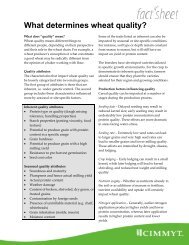


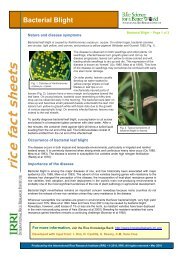

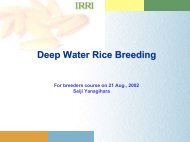
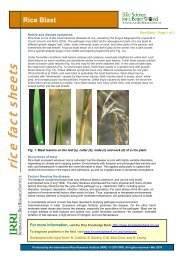
![International Standards' Organization â Rice Specification [ISO 7301]](https://img.yumpu.com/36696862/1/190x245/international-standards-organization-a-rice-specification-iso-7301.jpg?quality=85)
